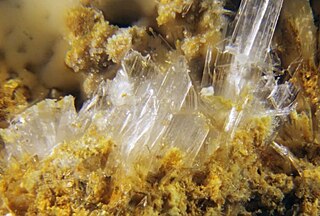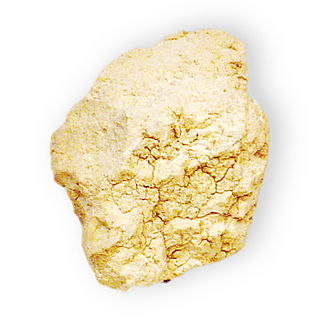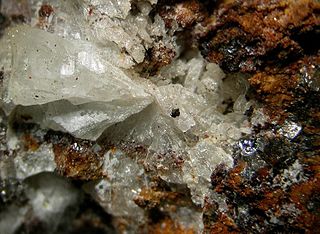
Bornite, also known as peacock ore, is a sulfide mineral with chemical composition Cu5FeS4 that crystallizes in the orthorhombic system (pseudo-cubic).

Glaucophane is the name of a mineral and a mineral group belonging to the sodic amphibole supergroup of the double chain inosilicates, with the chemical formula ☐Na2(Mg3Al2)Si8O22(OH)2.

Samarskite is a radioactive rare earth mineral series which includes samarskite-(Y), with the chemical formula (YFe3+Fe2+U,Th,Ca)2(Nb,Ta)2O8 and samarskite-(Yb), with the chemical formula (YbFe3+)2(Nb,Ta)2O8. The formula for samarskite-(Y) is also given as (Y,Fe3+,U)(Nb,Ta)O4.

The mineral group tantalite [(Fe, Mn)Ta2O6] is the primary source of the chemical element tantalum, a corrosion (heat and acid) resistant metal. It is chemically similar to columbite, and the two are often grouped together as a semi-singular mineral called coltan or "columbite-tantalite" in many mineral guides. However, tantalite has a much greater specific gravity than columbite (8.0+ compared to columbite's 5.2). Iron-rich tantalite is the mineral tantalite-(Fe) or ferrotantalite and manganese-rich is tantalite-(Mn) or manganotantalite.

Tusionite is a rare colorless to transparent to translucent yellow brown trigonal borate mineral with chemical formula: MnSn(BO3)2. The mineral is composed of 18.86% manganese, 40.76% tin, 7.42% boron, and 32.96% oxygen. It is a late stage hydrothermal mineral and occurs rarely in granite pegmatites in miarolitic cavities.

Hauerite is a manganese sulfide mineral with the chemical formula MnS2. It forms reddish brown or black octahedral crystals with the pyrite structure and it is usually found associated with the sulfides of other transition metals such as rambergite. It occurs in low temperature, sulfur rich environments associated with solfataras and salt deposits in association with native sulfur, realgar, gypsum and calcite.

Hausmannite is a complex oxide, or a mixed oxide, of manganese containing both di- and tri-valent manganese. Its chemical formula can be represented as MnIIMnIII2O4, or more simply noted as MnO·Mn2O3, or Mn3O4, as commonly done for magnetite, the corresponding iron oxide. It belongs to the spinel group and forms tetragonal crystals. Hausmannite is a brown to black metallic mineral with Mohs hardness of 5.5 and a specific gravity of 4.8.
Aeschynite-(Ce) is a rare earth mineral of cerium, calcium, iron, thorium, titanium, niobium, oxygen, and hydrogen with chemical formula (Ce,Ca,Fe,Th)(Ti,Nb)2(O,OH)6. Its name comes from the Greek word αισχύνη ("aeschyne") for "shame" because early chemists had difficulty with separations of titanium from zirconium.

Sugilite ( SOO-gə-lyte, -jee-) is a relatively rare pink to purple cyclosilicate mineral with the complex chemical formula KNa2(Fe, Mn, Al)2Li3Si12O30. Sugilite crystallizes in the hexagonal system with prismatic crystals. The crystals are rarely found and the form is usually massive. It has a Mohs hardness of 5.5–6.5 and a specific gravity of 2.75–2.80. It is mostly translucent. Sugilite was first described in 1944 by the Japanese petrologist Ken-ichi Sugi (1901–1948) for an occurrence on Iwagi Islet, Japan, where it is found in an aegirine syenite intrusive stock. It is found in a similar environment at Mont Saint-Hilaire, Quebec, Canada. In the Wessels mine in Northern Cape Province of South Africa, sugilite is mined from a strata-bound manganese deposit. It is also reported from Liguria and Tuscany, Italy; New South Wales, Australia and Madhya Pradesh, India.

Zincobotryogen is a hydrous sulfate mineral with the chemical formula (Zn,Mg,Mn)Fe3+(SO4)2(OH)·7H2O. It forms bright orange red monoclinic prismatic crystals that exhibit a vitreous to greasy luster. Its specific gravity is 2.201 and it has a Mohs hardness of 2.5.

Clausthalite is a lead selenide mineral, PbSe. It forms a solid solution series with galena PbS.

Gunningite is one of the minerals in the Kieserite group, with the chemical formula (Zn,Mn2+)SO4·H2O. Its name honours Henry Cecil Gunning (1901–1991) of the Geological Survey of Canada and a professor at the University of British Columbia.

Portlandite is a hydroxide-bearing mineral typically included in the oxide mineral class. It is the naturally occurring form of calcium hydroxide (Ca(OH)2) and the calcium analogue of brucite (Mg(OH)2).

Hectorite is a rare soft, greasy, white clay mineral with a chemical formula of Na0.3(Mg,Li)3Si4O10(OH)2.

Edingtonite is a white, gray, brown, colorless, pink or yellow zeolite mineral. Its chemical formula is BaAl2Si3O10·4H2O. It has varieties with tetragonal, orthorhombic or triclinic crystals.

Bazzite is a beryllium scandium cyclosilicate mineral with chemical formula Be3Sc2Si6O18. It crystallizes in the hexagonal crystal system typically as small blue hexagonal crystals up to 2 cm length. It has a Mohs hardness of 6.5–7 and a specific gravity of 2.77 to 2.85.

Fluellite is a mineral with the chemical formula Al2(PO4)F2(OH)•7H2O. The name is from its chemical composition, being a fluate of alumine (French).

Nambulite is a lithium bearing manganese silicate mineral with the chemical formula (Li,Na)Mn4Si5O14(OH). It is named after the mineralogist, Matsuo Nambu (born 1917) of Tohoko University, Japan, who is known for his research in manganese minerals. The mineral was first discovered in the Funakozawa Mine of northeastern Japan, a metasedimentary manganese ore.

Imogolite is an aluminium silicate clay mineral with the chemical formula Al2SiO3(OH)4. It occurs in soils formed from volcanic ash and was first described in 1962 for an occurrence in Uemura, Kumamoto prefecture, Kyushu Region, Japan. Its name originates from the Japanese word imogo, which refers to the brownish yellow soil derived from volcanic ash. It occurs together with allophane, quartz, cristobalite, gibbsite, vermiculite and limonite.

Vanuralite is a mineral of uranium with chemical formula: Al(UO2)2(VO4)2(OH)·11(H2O). It has yellow crystals and a Mohs hardness of 2. The name comes from the composition of the mineral.



















